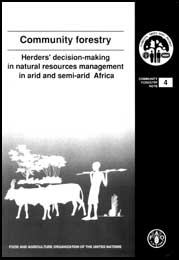
prepared by
Maryam Niamir
FOOD AND AGRICULTURE ORGANIZATION OF THE UNITED
NATIONS
Rome, 1990
FORESTS, TREES AND PEOPLE
Reprinted 1990, 1993
|
The designations employed and the presentation of material in
this publication do not imply the expression of any opinion whatsoever on the
part of the Food and Agriculture Organization of the United Nations concerning
the legal status of any country, territory, city or area or of its authorities,
or concerning the delimitation of its frontiers or boundaries. |
© FAO 1990
This electronic document has been scanned using optical character recognition (OCR) software and careful manual recorrection. Even if the quality of digitalisation is high, the FAO declines all responsibility for any discrepancies that may exist between the present document and its original printed version.
1.1 LKMS in the development process
1.2 Some definitions
Endnotes
2. LOCAL KNOWLEDGE AND SYSTEMS OF NATURAL RESOURCE MANAGEMENT
2.1 Descriptive and predictive knowledge
2.1.1 Forms of utilization of natural resources
2.1.2 Descriptive knowledge2.1.2.1 Climate
2.1.2.2 Soils and geomorphology
2.1.2.3 Plants and vegetation types
2.1.2.4 Water
2.1.2.5 Livestock
2.1.2.6 Wildlife
2.1.2.7 Traditional veterinary and human medicine
2.1.2.8 Measurement systemsEndnotes
2.2 Management practices2.2.1 Herd management
2.2.2 Range management2.2.2.1 Range use: mobility, rotation and deferment
2.2.2.2 Range evaluation and monitoring
2.2.2.3 Range improvement
2.2.2.4 Social controls on range use2.2.3 Tree and shrub management
2.2.3.1 Harvesting trees and shrubs
2.2.3.2 Regeneration of trees and shrubs
2.2.3.3 Protection of trees and shrubs2.2.4 Hay and fodder production
2.2.5 Water management2.2.5.1 Management of natural ponds
2.2.5.2 Water harvesting techniques
2.2.5.3 Well management
2.2.5.4 Other water resources2.2.6 Natural resources for food and medicine
2.2.7 AnalysisEndnotes
2.3 Organization of management2.3.1 Production systems and strategies
2.3.2.1 Rangeland tenure
2.3.2.2 Tenure of trees, water and other resources
2.3.2.3 Analysis2.3.3 Reserves and protected areas
2.3.4 Means of enforcement of rules
4. VIABILITY OF LOCAL KNOWLEDGE AND SYSTEMS
4.2.1 Descriptive knowledge
4.2.2 Management practices
4.2.3 Organization of management
5. PAST EXPERIENCE WITH LKMS AND DEVELOPMENT PROGRAMMES
5.1 Management associations and committees
5.1.1 Fulani clubs in Niger
5.1.2 Fulani Livestock Association in Nigeria
5.1.3 Bishnois movement in India
5.1.4 The Kgotla as a forum for modern land management in Botswana
5.1.5 Hima grazing society in Uganda
5.1.6 Fulani committee for managing a borehole in Senegal
5.1.7 Afar grazier associations of Ethiopia5.2 Grazing reserves and land tenure changes
5.2.1 Legalizing traditional grazing boundaries in the Sudan
5.2.2 Reviving grazing reserves in Somalia
5.2.3 Reviving grazing reserves in Zambia in 1940's
5.2.4 Reviving sacred groves in Madagascar
5.2.5 Hema grazing reserves in the Middle East and North Africa5.3.1 Restocking drought-hit Wodaabe Fulani of Niger
5.3.2 Veterinary programme in Mali
5.3.3 Using pastoralists as project researchers in Niger
6. POLICY IMPLICATIONS FOR SOCIAL FORESTRY DEVELOPMENT IN ARID AND SEMI-ARID LANDS OF AFRICA
6.1 Methodology for the analysis of LKMS
6.2 Potential applications
6.3 Prerequisites
6.4 Recommended follow-up activities
Endnotes
7. SUMMARY OF ISSUES AND CONCLUSIONS
7.1 Introduction
7.2 Descriptive knowledge
7.3 Management practices7.3.1 Herd management
7.3.2 Range management and social controls on grazing
7.3.3 Management of trees, shrubs and other resources